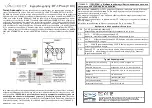
38
®
INSTALLATION
Do not run high voltage ignition transformer wires in the same conduit with flame detection wiring.
Do not run scanner wires in a conduit with line voltage circuits.
Ensure the frame of the ignition transformer is securely connected to control panel frame or prefera-
bly the burner frame.
The Flame-Monitor chassis (EB700) contains a transient suppressing device connected internally
across hot and neutral and then to the internal bracket. For this to be effective the chassis must be
screwed securely into the wiring subbase.
REMOTE DISPLAY
When the ED510 is to be remotely mounted on the front of the control panel, the ED580 cable must
contain a ferrite core, currently supplied by Fireye with the cable. High frequency currents flow more
to the surface of the conductor. The 60 Hz ground system, properly designed, has sufficient low-
impedance at 60 Hz to maintain all metal surfaces at the same ground reference. But, this same sys-
tem is unable to provide this at higher frequencies, because of the increased impedance caused by the
‘skin effect’. The purpose of the ferrite core is to provide a low-impedance at these higher frequen-
cies and absorb this unwanted energy.
Care must be taken not to route the ED580 cable in close proximity to any starter motor contactors
located in the control panel or across any high voltage ignition wires. Refer to Fireye bulletin E-8002
for proper installation.
COMMUNICATIONS
When interfacing Fireye controls to a communication system, be it an E500, PLC or other micropro-
cessor based device, ferrite cores should also be utilized. Proper twisted shielded pair cable must be
utilized. In a multi-drop system, the shields should be tied together within a cabinet and not to any
ground point. The shield at the source end of the cable of the multi-drop connection can then be ter-
minated to ground. Source end is defined as the originating end of the communication system
Care must be taken not to route communication cables in close proximity to any starter motor contac-
tors located in the control panel or across any high voltage ignition wires. Refer to Fireye bulletin E-
8002 for proper installation.
SCANNERS
The armored cable supplied with the Ultra-Violet and Infrared scanners should be connected to
equipment by means of a good mechanical connection such as a conduit fitting. It may be necessary
to utilize heat insulator (P/N 35-69) to isolate the sensing end of the scanner from boiler ground.
Care must be taken not to route the scanner cable across the high voltage ignition cable. The high
energy ignition cable should be checked periodically for cracking, connections and aging.
In applications using flame rod units and the ERT1 amplifier, it may be beneficial to route a separate
return wire from the S2 terminal to the flame rod assembly. This will minimize the effects of tran-
sient currents flowing into the Flame-Monitor.
In all cases, scanner wires should be routed in separate conduit and not joined with any high voltage
AC or ignition cables.











































